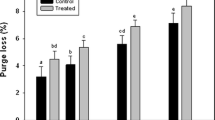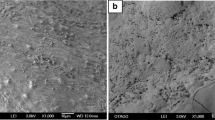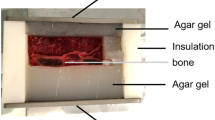Abstract
In this study, the effects of fibre direction and initial pH on the effectiveness of pulsed electric field (PEF) treatment (10 kV, 90 Hz, 20 μs) to improve the quality of beef Longissimus muscle (LL) was evaluated. The traits studied included tenderness (shear force), water loss, meat colour, lipid oxidation and post-mortem proteolysis. Beef LL muscles of three different pH ranges (5.5–5.8, 5.8–6.1 and >6.1) were obtained from 16 bull carcasses. The LL muscles were removed from the carcasses 24 h post-mortem and treated with pulsed electric field within 6 h. No significant effect was found on total water loss, shear force, meat colour and lipid stability between the treated and the corresponding non-treated control samples due to fibre direction or initial pH. Increased proteolysis was found in treated samples as evident by increases in troponin-T and desmin degradation. A larger increase in proteolysis was observed in low-pH (5.5–5.8) samples compared to the high-pH (>6.1) samples which was reflected in shear force measurements.





Similar content being viewed by others
References
Aalhus, J. L., Jones, S. D. M., Tong, A. K. W., Jeremiah, L. E., Robertson, W. M., & Gibson, L. L. (1992). The combined effects of time on feed, electrical stimulation and aging on beef quality. Canadian Journal of Animal Science, 72(3), 525–535.
Abril, M., Campo, M. M., Ӧnenḉ, A., Sanudo, C., Alberti, P., & Negueruela, A. I. (2001). Beef colour evolution as a function of ultimate pH. Meat Science, 58, 69–78.
AMSA. (2012). Meat color measurement guidelines. Retrieved 26 July 2013, from American Meat Science Association http://www.meatscience.org http://www.meatscience.org/uploadedFiles/Publications_Resources/AMSA%20Meat%20Color%20Guidelines%20Second%20Edition.pdf
Babiker, S. A., & Lawrie, R. A. (1983). Post-mortem electrical stimulation and high temperature ageing of hot-deboned beef. Meat Science, 8(1), 1–20.
Bee, G., Anderson, A. L., Lonergan, S. M., & Huff-Lonergan, E. (2007). Rate and extent of pH decline affect proteolysis of cytoskeletal proteins and water-holding capacity in pork. Meat Science, 76, 359–365.
Bekhit, A. E. D. (2003). The role of metmyoglobin reducing activity in the maintenance of fresh meat colour. PhD Thesis, Lincoln University, New Zealand.
Bekhit, A. E. D., Farouk, M. M., Cassidy, L., & Gilbert, K. V. (2007). Effects of rigor temperature and electrical stimulation on venison quality. Meat Science, 75, 564–574.
Bekhit, A. E. D., Hopkins, D. L., Fahri, F. T., & Ponnampalam, E. N. (2013). Oxidative processes in muscle systems and fresh meat: sources, markers and remedies. Comprehensive Reviews in Food Science and Food Safety, 12, 565–597.
Bekhit, A. E. D., van de Ven, R., Hopkins, D. L., Suwandy, V., & Fahri, F. (2014). Effect of pulsed electric field treatment on cold boned muscles of different potential tenderness. Food and Bioprocess Technology, 7, 3136–3146.
Butler, D. (2009). asreml: asreml fits the linear mixed model. R package version 3.0-1. www.vsni.co.uk.
Castigliego, L., Armani, A., & Guidi, A. (2012). Meat color. In Y. H. Hui (Ed.), Handbook of meat and meat processing (2nd ed., pp. 81–106). New York: CRC Press.
Cheng, Q., & Sun, D. W. (2008). Factors affecting the water holding capacity of red meat products: a review of recent research. Critical Reviews in Food Science and Nutrition, 48, 137–159.
Chrystall, B. B. & Devine, C. E. (1991). Quality assurance for tenderness. Publication No. 872. Meat Industries Research Institute of New Zealand.
Claeys, E., Smet, S. D., Balcaen, A., Raes, K., & Demeyer, D. (2004). Quantification of fresh meat peptides by SDS-PAGE in relation to ageing time and taste intensity. Meat Science, 67(2), 281–288.
R Core Team (2013). R: a language and environment for statistical computing. R Foundation for Statistical Computing, Vienna, Austria. ISBN 3-900051-07-0, URL http://www.R-project.org/
Cornforth, D. (1994). Color—its basis and importance. In A. M. Pearson & T. R. Dutson (Eds.), Quality attributes and their measurement in meat, poultry and fish products (pp. 34–78). USA: Springer.
Dransfield, E. (1994). Optimisation of tenderisation, ageing and tenderness. Meat Science, 36, 105–121.
Farouk, M. M., Mustafa, N. M., Wu, G., & Krsinic, G. (2012). The “sponge effect” hypothesis: an alternative explanation of the improvement in the water holding capacity of meat with ageing. Meat Science, 90, 670–677.
Geesink, G. H., Bekhit, A. D., & Bickerstaffe, R. (2000). Rigor temperature and meat quality characteristics of lamb longissimus muscle. Journal of Animal Science, 78, 2842–2848.
Ha, M. H. (2012). Characterisation of cysteine proteases and their catalytic impact on meat myofibril and meat connective tissue proteins. Master of Science thesis, University of Otago, New Zealand.
Ha, M. H., Bekhit, A. E. D., Carne, A., & Hopkins, D. L. (2013). Characterisation of kiwifruit and asparagus enzyme extracts, and their activities toward meat proteins. Food Chemistry, 136, 989–998.
Han, J., Morton, J. D., Bekhit, A. E. D., & Sedcole, J. R. (2009). Pre-rigor infusion with kiwifruit juice improves lamb tenderness. Meat Science, 82(3), 324–330.
Ho, C. Y., Stromer, M. H., & Robson, R. M. (1994). Identification of the 30 kDa polypeptide in post mortem skeletal muscle as a degradation product of troponin-T. Biochimie, 76(5), 369–375.
Ho, C. Y., Stromer, M. H., & Robson, R. M. (1996). Effect of electrical stimulation on postmortem titin, nebulin, desmin and troponin-T degradation and ultrastructural changes in bovine longissimus muscle. Journal of Animal Science, 74(7), 1563–1575.
Huff-Lonergan, E., & Lonergan, S. M. (2005). Mechanisms of water-holding capacity of meat: the role of postmortem biochemical and structural changes. Meat Science, 71(1), 194–204.
Hughes, J., Oiseth, S., Purslow, P., & Warner, R. D. (2014). A structural approach to understanding the interactions between colour, water-holding capacity and tenderness. Meat Science, 98, 520–532.
Hwang, I. H., Devine, C. E., & Hopkins, D. L. (2003). The biochemical and physical effects of electrical stimulation on beef and sheep meat tenderness. Meat Science, 65(2), 677–691.
Koohmaraie, M., & Shackelford, S. D. (1991). Effect of calcium chloride infusion on the tenderness of lamb fed a b-adrenergic agonist. Journal of Animal Science, 69, 2463–2471.
Ledward, D. A. (1985). Post-slaughter influences on the formation of metmyoglobin in beef muscles. Meat Science, 15, 149–171.
Lomiwes, D., Farouk, M. M., Wu, G., & Young, O. A. (2014). The development of meat tenderness is likely to be compartmentalised by ultimate pH. Meat Science, 96, 646–651.
Mancini, R. A., & Hunt, M. C. (2005). Current research in meat color. Meat Science, 71(1), 100–121.
Marino, R., Albenzio, M., Malva, A. D., Santillo, A., Loizzo, P., & Sevi, A. (2013). Proteolytic pattern of myofibrillar protein and meat tenderness as affected by breed and aging time. Meat Science, 95, 281–287.
Marsh, B. B., Ringkob, T. P., Russell, R. L., Swartz, D. R., & Pagel, L. A. (1987). Effects of earl-postmortem glycolytic rate on beef tenderness. Meat Science, 21(4), 241–248.
McBride, M. A., & Parrish, J. F. C. (1977). The 30,000-dalton component of tender bovine longissimus muscle. Journal of Food Science, 42, 1627–1629.
Micklander, E., Bertram, H. C., Marnø, H., Bak, L. S., Andersen, H. J., Engelsen, S. B., & Nørgaard, L. (2005). Early post-mortem discrimination of water-holding capacity in pig longissimus muscle using new ultrasound method. LWT - Food Science and Technology, 38, 437–445.
O’Dowd, L. P., Arimi, J. M., Noci, F., Cronin, D. A., & Lyng, J. G. (2013). An assessment of the effect of pulsed electrical fields on tenderness and selected quality attributes of post rigour beef muscle. Meat Science, 93(2), 303–309.
O’Halloran, G. R., Troy, D. J., & Buckley, D. J. (1997). The relationship between early post-mortem pH and the tenderisation of beef muscles. Meat Science, 45(2), 239–251.
Olson, D. G., & Parrish, F. C., Jr. (1977). Relationship of myofibril fragmentation index to measures of beefsteak tenderness. Journal of Food Science, 42, 506–509.
Schafer, A., Rosenvold, K., Purslow, P. P., Andersen, H. J., & Henckel, P. (2002). Physiological and structural events post mortem of importance for drip loss in pork. Meat Science, 61, 355–366.
Silva, J. A., Patarata, L., & Martins, C. (1999). Influence of ultimate pH on bovine meat tenderness during ageing. Meat Science, 52, 453–459.
Strydom, P. E., & Frylinck, L. (2014). Minimal electrical stimulation is effective in low stressed and well fed cattle. Meat Science, 96, 790–798.
Sun, X., Chen, K. J., Berg, E. P., Newman, D. J., Schwartz, C. A., & Keller, W. L. (2014). Prediction of troponin-T degradation using color image texture features in 10 d aged beef longissimus steaks. Meat Science, 96, 837–842.
Suwandy, V., Carne, A., van de Ven, R., Bekhit, A. E. D., & Hopkins, D. L. (2015). Effect of pulsed electric field on the proteolysis of cold boned beef M. Longissimus lumborum and M. Semimembranosus. Meat Science, 100, 222–226.
Töpfl, S. (2006). Pulsed electric fields (PEF) for permeabilization of cell membranes in food-and bioprocessing: applications, process and equipment design and cost analysis. Ph.D thesis, Universität Berlin, Germany.
Watanabe, A., & Devine, C. (1996). Effect of meat ultimate pH on rate of titin and nebulin degradation. Meat Science, 42, 407–413.
Watanabe, A., Daly, C. C., & Devine, C. E. (1996). The effects of the ultimate pH of meat tenderness changed during ageing. Meat Science, 42(1), 67–78.
Wheeler, T. L., & Koohmaraie, M. (1999). The extent of proteolysis is independent of sacromere length in lamb longissimus and psoas major. Journal of Animal Science, 77, 2444–2451.
Wiklund, E., Stevenson-Barry, J. M., Duncan, S. J., & Littlejohn, R. P. (2001). Electrical stimulation of red deer (Cervus elaphus) carcasses—effects on rate of pH-decline, meat tenderness, colour stability and water-holding capacity. Meat Science, 59(2), 211–220.
Yates, L. D., Dutson, T. R., Caldwell, J., & Carpenter, Z. L. (1983). Effect of temperature and pH on the post-mortem degradation of myofibrillar proteins. Meat Science, 9, 157–179.
Zhang, Q., Barbosa-Canovas, G. V., & Swanson, B. G. (1995). Engineering aspects of pulsed electric field pasteurisation. Journal of Food Engineering, 25, 261–281.
Acknowledgments
The financial support by Meat and Livestock Australia and Australian Meat Processor Corporation Ltd. is greatly acknowledged. The assistance of the management and staff of Alliance Group and the team at Pukeuri Plant is also acknowledged.
Author information
Authors and Affiliations
Corresponding author
Rights and permissions
About this article
Cite this article
Suwandy, V., Carne, A., van de Ven, R. et al. Effect of Pulsed Electric Field Treatment on the Eating and Keeping Qualities of Cold-Boned Beef Loins: Impact of Initial pH and Fibre Orientation. Food Bioprocess Technol 8, 1355–1365 (2015). https://doi.org/10.1007/s11947-015-1498-8
Received:
Accepted:
Published:
Issue Date:
DOI: https://doi.org/10.1007/s11947-015-1498-8




